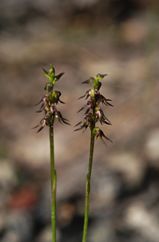Despite the lack of orchids in the field at the present time, we still need to stay optimistic that the autumn rains will eventually come, and with them, hopefully, our autumn orchid species will still appear.
The Sharp Midge Orchid Corunastylis despectans and the Bearded Midge Orchid Corunastylis morrisii are the sum total of my observations for the month, and they are certainly very sparse on the ground. I have seen only five Bearded Midge Orchids, and about ten Sharp Midge Orchids. Generally they have been very small, although there were two very fine specimens of Sharp Midge Orchids that had finished flowering by the time I discovered them.

Sharp Midge Orchid
I have not seen any of our third species of Midge Orchids, Fringed Midge Orchids Corunastylis ciliata, which are usually the first of our autumn orchids to appear. Midge Orchids, as their name suggests, have tiny, insect-like flowers. They have a cylindrical leaf that is fused with the flower stem for most of their length. They are not easy to find, as they are inconspicuous where they grow in amongst grasses, rushes, sedges and small shrubs. However, they are worth looking for, and always exciting to track down.
There are three species of Greenhoods that could be observed during autumn: Tiny Greenhood Pterostylis parviflora, Brown Tipped Greenhood Pterostylis sp. aff parviflora and the much larger Autumn Greenhood Pterostylis sp. aff revoluta. The last is a very attractive species, with the labellum protruding underneath the striped hood.

Autumn Greenhood
Parson’s Bands Eriochilus cucullatus, Autumn Bird Orchids Chiloglottis reflexa and Tall Bird Orchids Chiloglottis trilabra may also be flowering.
All of these orchids are photographed and described in Orchids of the Anglesea District, available from Angair.
Please let us know about any of your orchid observations.
Margaret MacDonald